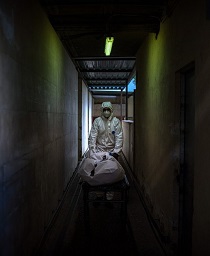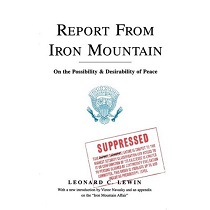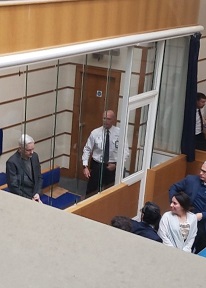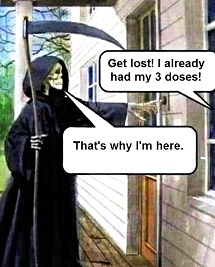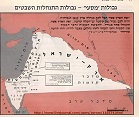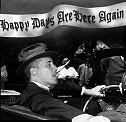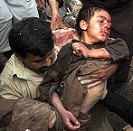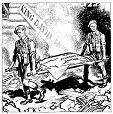Trying Not to Give Peace a Chance
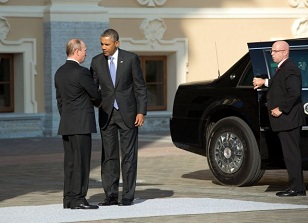
President Vladimir Putin of Russia welcomes President
Barack Obama to the G20 Summit at Konstantinovsky
Palace in Saint Petersburg, Russia, Sept. 5, 2013.
Exclusive: The trust between President Obama and President Putin helped avert a U.S. war on Syria and got Iran to agree to limit its nuclear program, but the neocon-driven crisis in Ukraine has dashed hopes of building on that success for a more peaceful world.
The unnecessary and regrettable conflict between the U.S. and Russia over Ukraine brings to mind sad remembrances of important junctures at which I watched – as a citizen and a CIA analyst – chances for genuine peace with Russia frittered away.
How vividly I recall John Kennedy’s inaugural address when he bid us to ask not what our country could do for us, but rather what we could do for our country. Then and there I decided to put in the service of our government whatever expertise I could offer from my degrees in Russian. So I ended up in Washington more than a half-century ago.
The missed chances for peace did not wait. On April 17, 1961, a ragtag CIA-trained-and-funded paramilitary group of some 1,500 men went ashore on Cuba’s Bay of Pigs and were defeated in three days by Cuban forces led by Fidel Castro. CIA Director Allen Dulles and the senior military had intended to mousetrap young President Kennedy into committing U.S. military forces to a full-scale invasion, in order to bring what we now blithely call “regime change” to Cuba.
The planned mousetrap, shown for example in Dulles’s own handwriting on paper found in his study after his death, didn’t work. Kennedy had warned Dulles emphatically that he would not send U.S. armed forces into the fray. He stuck to that decision, and thereby created a rancid hatred on the part of Dulles, whom Kennedy fired, and from the Joint Chiefs of Staff, whom Kennedy should also have fired. The top generals, whom Deputy Secretary of State George Ball described as a “sewer of deceit,” had been in on the cabal.
The failed invasion prompted Castro to strengthen ties with the Soviet Union, which in turn led to the Cuban missile crisis of October of 1962. I watched with particular attention that seminal event unfold, since I had orders to report to Army Infantry Officer Orientation School at Fort Benning on Nov. 3, 1962. (When we began our training, we had to postpone the segment on highly touted, relatively new weapons – grenade launchers, almost all of which had been scooped up and taken to Key West a few weeks before.)
As James Douglass details in his masterful JFK and the Unspeakable, Kennedy’s “failure” to send forces to rescue the paramilitary group on the beach at the Bay of Pigs was a sign of cowardice in the eyes of Allen Dulles; his brother, former Secretary of State John Foster Dulles; and the Joint Chiefs.
The peaceful resolution of the Cuban missile crisis disappointed Air Force General Curtis LeMay and colleagues on the Joint Staff who wished to use Moscow’s adventurism as a casus belli – not only to achieve regime change in Cuba, but also to launch a nuclear attack on the Soviet Union itself. Yes, madness – but real enough. (And there’s still some of it around today.)
Kennedy and Khrushchev were acutely aware of how close they had come to incinerating much of the world – and decided to find common ground in order to prevent a re-run of the near-calamity. In a stunningly conciliatory speech at American University on June 10, 1963, Kennedy appealed for a re-examination of American attitudes towards peace, the Soviet Union and the Cold War, famously remarking, “If we cannot end now our differences, at least we can make the world safe for diversity.”
The Limited Nuclear Test Ban Treaty was signed by the U.S. and the U.S.S.R. on Aug. 5, 1963, and further improvement in relations was expected – and strongly opposed by the cold warriors among the Joint Chiefs. For them it was the last straw when President Kennedy issued two Executive Orders for a staged withdrawal of virtually all U.S. troops from Vietnam. They joined forces with Allen Dulles and others with feelings of revenge or fear that Kennedy was too soft on Communism.
And so, according to the persuasive case made by Douglass in JFK and the Unspeakable, they joined in a plot to kill Kennedy and derail for a generation the chance for real peace.
Chance #2 – Reykjavik, 1986
By the next high-profile opportunity for a comprehensive peace in 1986, I had spent most of my CIA career focusing on Soviet foreign policy and was able to tell the senior U.S. officials I was briefing that Mikhail Gorbachev, in my view, was the real deal. Even so, I was hardly prepared for how far Gorbachev was willing to go toward disarmament. At the 1986 summit with President Ronald Reagan in Reykjavik, Iceland, Gorbachev proposed that all nuclear weapons be eliminated within ten years.
Reagan reportedly almost rose to the occasion, but was counseled to reject Gorbachev’s condition that any research on anti-ballistic missiles be confined to laboratories for that decade. “Star Wars,” the largest and most wasteful defense-industry corporate welfare program, won the day.
I know the characters who, for whatever reason, danced to the tune of “Star Wars” – Reagan’s wistful wish for an airtight defense against strategic missiles, which the most serious engineers and scientists have said from the start, and still say, can always be defeated, and cheaply.
The naysayers to peace included ideologues like CIA Director William Casey and Defense Secretary Caspar Weinberger, windsocks like CIA Deputy Director Robert Gates and one of his protégés, Fritz Ermarth, a viscerally anti-Russian functionary and former Northrop Corporation employee who was a Special Assistant to the President and Senior Director of Soviet and European Affairs at the National Security Council (NSC) during Reykjavik.
According to author Jim Mann, several years after Reykjavik, Ermarth reflected on how he had been wrong in being overly suspicious of Gorbachev and how the intuition of Ronald Reagan and Secretary of State George Shultz had been more perceptive.
As for “Star Wars,” Jack Matlock, whom Ermarth replaced at the White House and NSC, attributed the President’s refusal to compromise on anti-ballistic missile work beyond the laboratory to a mistaken belief that the proposed restrictions would be detrimental to the program. Matlock argued that the restrictions would have had little effect on research that was still in its very early stages. Matlock, who later served as U.S. Ambassador to Russia, remains among the most widely respected specialists on Russia since George Kennan.
A career Foreign Service officer, Matlock missed the opportunity that Ermarth had to be initiated into the ethos of defense contractors like Northrop. According to its website: “From detection to tracking to engagement, Northrop Grumman is bringing its entire suite of expertise in systems integration, high-tech weaponry, and domain knowledge to bear on the challenge of a layered missile defense capability.”
Also, in contrast to Matlock, Robert Gates was elected a director of Northrop Grumman on April 24, 2002, during one of his private-sector breaks between top jobs in the national security apparatus.
So, the Reykjavik summit was another blown chance for real peace that would have been beneficial for the world – but for Northrop Grumman, not so much.
Chance #3 – The Soviet Union Falls Apart
By the late 1980s and early 1990s with the crumbling of the Soviet bloc and then the collapse of the Soviet Union, another opportunity for genuine peace and nuclear disarmament presented itself, but blowing such chances had become predictable.
The failure of the Communist regimes in the U.S.S.R. and in Eastern Europe brought with it a unique opportunity to create the kind of peace that Europe had not seen in modern times. It was an historic moment. President George H. W. Bush sensed this, even before the Berlin Wall fell, when he told a German audience in Mainz on May 31, 1989, “the time is ripe for Europe to be whole and free.”
To his credit, President Bush, the elder, refused to gloat over the historic concessions being made by Soviet President Gorbachev. Bush said he would not dance in celebration of the Berlin Wall coming down and assured Gorbachev that he had “no intention of seeking unilateral advantage from the current process of change in East Germany and in other Warsaw Pact countries.”
In early February 1990, Secretary of State James Baker told Gorbachev there would be “no extension of NATO’s forces one inch to the East,” provided that the Russians agreed that a united Germany could become a member of NATO.
As historian Mary Elise Sarotte has pointed out, “Such statements helped to inspire Gorbachev to agree, on Feb. 10, 1990, to internal German unification” – a bitter pill to swallow when earlier 20th Century history is taken into account. The undertaking not to push NATO east was in the nature of a gentlemen’s agreement; nothing was committed to paper, and as the years went by, so did the gentlemen.
While U.S. media have generally ignored this sordid history, one can find chapter and verse in Steve Weissman’s recent article, “Exposing the Cold War Roots of America’s Coup in Kiev.” And Der Spiegel published an even more detailed account in November 2009 in “Did the West Break Its Promise to Moscow?”
Double-Cross?
It didn’t take long, however, for Official Washington’s “triumphalism” to take over. “Free-market” experts were dispatched to Moscow to apply “shock therapy” to the Russian economy, a process that gave rise to a handful of well-connected “oligarchs” plundering the nation’s wealth while poverty spread among the masses of the Russian people.
With similar arrogance, the U.S. government cast aside Russian objections to NATO expansion. On March 12, 1999, the Czech Republic, Hungary and Poland joined NATO. On March 29, 2004, Bulgaria, Estonia, Latvia, Lithuania, Romania, Slovakia and Slovenia also became NATO members. (Albania and Croatia joined on April 1, 2009.)
In a major speech in Munich on security policy on Feb. 2, 2007, Russian President Vladimir Putin, who was reasserting Russian self-respect, was blunt:
“I think it is obvious that NATO expansion does not have any relation to the modernization of the Alliance itself or with ensuring security in Europe. On the contrary, it represents a serious provocation that reduces the level of mutual trust. And we have the right to ask: against whom is this expansion intended? And what happened to the assurances our western partners made after the dissolution of the Warsaw Pact? Where are those declarations today? No one even remembers them.”
In no way impressed by Putin’s protestations, and having already added 12 countries on or near Russia’s borders, NATO leaders kept on looking east. On April 3, 2008, at a summit in Bucharest, the heads of state of the alliance issued a declaration that included this relating to NATO plans for Ukraine:
“NATO welcomes Ukraine’s and Georgia’s Euro-Atlantic aspirations for membership in NATO. We agreed today that these countries will become members of NATO.”
Though the timing was left up in the air, Russia reacted strongly to the prospect, as anyone with an ounce of sense could have predicted.
Regarding Ukraine, the last straw came almost six years later when the U.S. Assistant Secretary of State for European Affairs, neocon prima donna Victoria Nuland, along with U.S. Ambassador to Ukraine Geoffrey Piatt and others with an interest in stirring up trouble in Ukraine, helped precipitate a putsch that placed U.S. lackeys in charge of a new government for Ukraine on Feb. 22, 2014.
In a major speech ten days later, Putin said:
“Our colleagues in the West … have lied to us many times, made decisions behind our backs, placed before us an accomplished fact. This happened with NATO’s expansion to the east, as well as the deployment of military infrastructure at our borders. … It happened with the deployment of a missile defense system...
“They are constantly trying to sweep us into a corner. … But there is a limit to everything. And with Ukraine, our Western partners have crossed the line. … If you compress the spring all the way to its limit, it will snap back hard. … Today, it is imperative to end this hysteria and refute the rhetoric of the cold war. … Russia has its own national interests that need to be taken into account and respected.”
Quotes Around Russia’s National ‘Interests’
Putin’s speech riled those who run the editorial section of the neocon Washington Post, who on March 20 denounced “Putin’s expansionist ambitions” and reviled those who are “rushing to concede ‘Russian interests’ in Eurasia.” The Post lamented that President Barack Obama and Secretary of State John Kerry were among those who have said they recognize such “interests” in Ukraine.
And the Post gave space to former Bush national security adviser Stephen Hadley who wants NATO to “restate its commitment of the 2008 Bucharest Communiqué to ultimate NATO membership to Ukraine,” and to “roll back the takeover of Crimea.”
Oddly, abutting Hadley’s drivel was an op-ed penned by former Carter national security adviser Zbigniew Brzezinski. After excoriating “Russian aggression [and] Putin’s thuggish tactics,” and comparing him to “a Mafia gangster,” Hitler and Mussolini, Brzezinski nonetheless concluded: “The West should reassure Russia that it is not seeking to draw Ukraine into NATO.”
Henry Kissinger, no peacenik he, wrote the same thing in a Washington Post op-ed of March 5, 2014: “Ukraine should not join NATO, a position I took seven years ago, when it last came up.”
Such suggestions from seasoned hands are not new. George Kennan, the author of the post WWII “containment policy,” was a fierce opponent of the eastward expansion of NATO.
If today’s Ukraine crisis is not to spin further out of control, President Obama needs to tell the neocons within his own administration – as well as Secretary of State Kerry – to cease and desist with their inflammatory rhetoric and their demands for confrontation.
If the objective of these hardliners was to poison U.S.-Russian relations, they have done a good job. However, if they had illusions that Russia would stand for Ukraine being woven into NATO, they should take a course in Russian history.
Or is it possible that some of the administration’s hawks are offended that Putin provided a path away from a near U.S. military assault on Syria last summer by getting Syrian President Bashar al-Assad to agree to surrender his chemical weapons?
In a highly unusual Sept. 11, 2013, op-ed in the New York Times, “A Plea for Caution From Russia,” Putin recalled that our countries “were allies once, and defeated the Nazis together,” adding, “My working and personal relationship with President Obama is marked by growing trust.” (For more on this question of Obama-Putin cooperation, see Consortiumnews.com’s “What Neocons Want from Ukraine Crisis.”)
Not Rising to the Bait
The good news, if there is any coming from the Ukraine mess, is that Putin has avoided returning the personal invective hurled at him. He does not want to burn any bridges. It would hardly be surprising, at this stage, were Putin to badmouth Secretary Kerry, but Putin has shown some restraint, while still putting Kerry in his place.
At a news conference on March 4, Putin was asked about Kerry’s harsh attitude and whether it might be time to recall the Russian ambassador to the U.S. Putin replied:
“The U.S. Secretary of State is certainly an important person, but he is not the ultimate authority that determines the United States foreign policy. … [Recalling our ambassador] would be an extreme measure. … I really don’t want to use it because I think Russia is not the only one interested in cooperation with partners on an international level and in such areas as economy, politics and foreign security; our partners are just as interested in this cooperation. It is very easy to destroy these instruments of cooperation and it would be very difficult to rebuild them.”
Putin also fielded a question from six-year-old Albina toward the end of his marathon “Direct Line with Vladimir Putin” TV conversation on April 17. She asked, “Do you think President Obama would save you if you were drowning?”
[Putin:] “I sure hope this doesn’t happen, but you know that there are personal relationships as well as relations between governments. I can’t say that I have a special personal relationship with the U.S. President, but I think he is a decent man and brave enough. So, I think he definitely would.”
However, as for that “growing trust” with President Obama – and the chance for more progress toward a more peaceful world – the U.S. hardliners who exacerbated the political situation in Ukraine, turning it into an international confrontation, appear to have succeeded in blocking the latest best hope for U.S.-Russian cooperation.
But there remains an obvious solution to at least prevent matters from getting worse. The beneficiaries of “regime change” in Kiev, who now find themselves in power at least for the nonce, need to make clear that Ukraine will not attempt to join NATO; and NATO needs to make clear that it has no intention of folding Ukraine into NATO. (Polling shows a lack of enthusiasm among Ukrainians for NATO, in any case.)
This is the most important step to be taken to rebuild trust – or at least prevent the further deterioration of trust – between Obama and Putin.
At his press conference on March 4, President Putin complained about “our Western partners” continuing to interfere in Ukraine.
“I sometimes get the feeling,” he said, “that somewhere across that huge puddle, in America, people sit in a lab and conduct experiments, as if with rats, without actually understanding the consequences of what they are doing. Why do they need to do this?”
Putin has taken some pains to hold the door open to a restoration of trust with President Obama. From the U.S. side, this might be the right time to close down the lab where all those destructive “regime change’” experiments take place.
___________________________________________________________________________________
Ray McGovern works with Tell the Word, a publishing arm of the ecumenical Church of the Saviour in inner-city Washington. He served under seven presidents and nine CIA directors while serving as a CIA analyst for 27 years, and now serves on the Steering Group of Veteran Intelligence Professionals for Sanity (VIPS). Ray entered the CIA as an analyst on the same day as the late CIA analyst Sam Adams (a direct descendant of John Adams, by the way), and was instrumental in founding Sam Adams Associates for Integrity in Intelligence.
___________________________________________________________________________________
Article published here: Consortiumnews.com. Photo: Official White House Photo by Pete Souza
URL: http://www.a-w-i-p.com/index.php/2014/04/24/trying-not-to-give-peace

